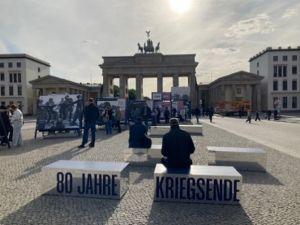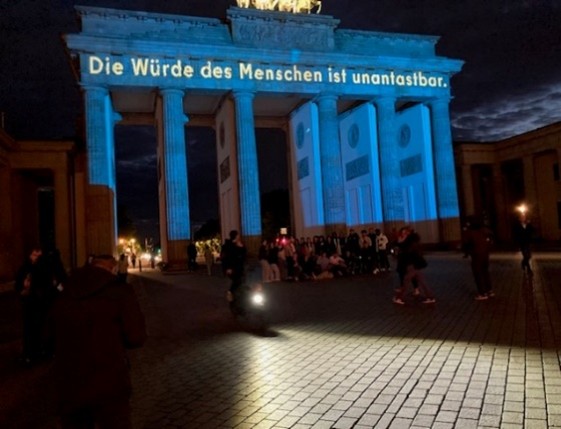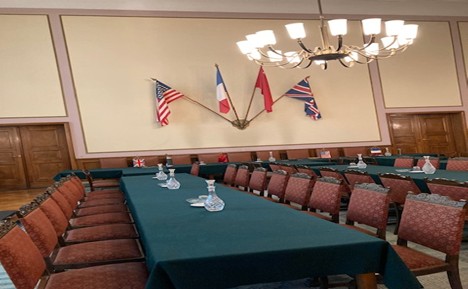VE Day - 8 May 2025 Berlin - 80 years on

Berlin, on the 80th anniversary of the end of World War 2 on 8 May 2025, was where we visited some significant sites, concluding with the symbolism of the Brandenburg Gate. The “80 Jahre Kriegsende” exhibition was displayed prominently during the day with an evening display in blue of the German basic code concluded the day.
Article 1: Every human being is valuable. Article 1 protects human beings' dignity. Dignity means: All human beings have value. It recalled the universal lesson of German history with the commitment of the German Basic Law to stand up resolutely for freedom, democracy, and human rights in the world.
Next was the 1939-45 British war cemetery, established in 1945 as the central burial ground for allied aircrew shot down over Berlin from numerous bombing raids. It also held the graves of prisoners of war (POWS) who had died and were previously interred elsewhere in Eastern Germany.

Some died during the Long March 1945 from their Eastern POW camps as the Russian army advanced. These walks were undertaken in harsh winter conditions, where many succumbed to disease, accidental Allied bombing, and random acts of violence.
Two graves interested.
- Lieutenant Albert Michael Sinclair was the only POW shot escaping at Colditz Castle on 25 August 1944. For his actions, he was awarded the Distinguished Service Order, posthumously, being the only POW to receive a medal while in captivity.
- A Great Escaper, Flight Lieutenant Denys Oliver Street (21) was one of the fifty shot on Hitler’s instructions after escaping from Stalag Luft 3 at Sagan. He was buried near his father who was then the Permanent Secretary to the Air Ministry. His grave is inscribed with “Like so many he did his duty twice over and met death with fortitude.”

Next to the Armistice, which was originally signed on May 7, 1945, at Reims, France. General Alfred Jodl, the Chief of Staff of the German Army, was authorised by the German President, Admiral Karl Dönitz to sign. Lt. Gen. Walter Bedell Smith led the Allied delegation, representing General Eisenhower who had apparently refused to meet the Germans until they surrendered. However, the Soviet Chief of Staff, Gen. Alexei Antonov expressed concern that continued fighting in the east between Germany and the Soviet Union made the Reims surrender look like a separate peace. The Soviet command wanted the Act of Military Surrender, with certain additions and alterations, to be signed in Berlin.
A second surrender document was signed in Berlin on 8 May 1945, representing the official and legal surrender of the Third Reich. All the countries that had participated in the Act of Surrender met at Tempelhof airport, Berlin to be transported to Karlshorst.
Soviet State Secretary Vyshinsky landed first, followed at noon by British Air Marshal Tedder and the Commander of the American long-distance flight forces, General Spaatz. Then, General Jean de Lattre de Tassigny, the Commander-in-Chief of the French Army arrived to be followed by the German delegation who were received by the Soviet soldiers. They were brought across the destroyed Berlin city to the virtually undamaged residential area of Karlshorst. The museum stressed the liberation from National Socialism, while remembering victims of German crimes during the Second World War.

The last destination was the Platform 17 memorial, Grunewald Station. It commemorates the deportation of thousands of Jews on Deutsche Reichsbahn trains to the death camps from Autumn 1941 onwards. Now, a desolate concrete train track with 186 plaques on either side that record the dates and numbers deported, if known, and their ultimate location. It reads as a litany of the names of the notorious concentration camps. Vegetation has been allowed to spread between the tracks, endorsing that no train should ever leave the station from this track again.

These four locations presented contrasting images from the noise of central Berlin, a peaceful morning reminiscent of many war cemeteries, the Karlshorst Museum marking the official end of World War 2 in Europe to solitude and sadness. At the Brandenburg Gate, many nationalities stood to reflect. In Karlshorst, many Germans had brought families including one German lady who confirmed that she had never visited previously. With 8 May 1945 being a public holiday in Berlin, curiosity had led her here. The silence at Platform 17 was interrupted only by a senior meeting of officials who was planning for a ministerial visit later that week.
More 80th commemoration events lie ahead this year. The Japanese surrender in August ended the War against Japan when the atomic bomb was dropped. The Nuremberg trials started in November 1945 against the Third Reich commanders seeking accountability for war crimes. Its importance was articulated by Robert Jackson in his opening remarks stating:
“The privilege of opening the first trial in history for crimes against the peace of the world imposes a grave responsibility. The wrongs which we seek to condemn and punish have been so calculated, so malignant, and so devastating, that civilization cannot tolerate their being ignored, because it cannot survive their being repeated.”
Questions arose then about how best to remember such horrific events and avoid their repetition and now, in commemorating anniversaries. As those who remember are fewer, soon, no one will be able to provide first-hand testimony. Each site offered us important ways to remember. For us as lawyers: -
We can remember by stressing the importance of studying law. Modules follow on directly from the events of World War 2. These comprise studying basic law and human rights (the European Convention on Human Rights (W111)), the foundation of the European Union (W330) and specialism in studying Nazi Germany and the Holocaust (W340). We need to continue to meet the challenges of remembrance. With a diversity of remembrance practices, these need to include the victors and the vanquished but the victims of war.
80 years on from VE Day, remembering these events was so critically important, especially in facing current world challenges.

Gillian Mawdsley
Gillian is a practicing Scottish solicitor who teaches a number of modules at the OU as well as Edinburgh University. She has longstanding interests in the intersection of history and law and is a Commonwealth War Grave volunteer. She is writing a paper for a conference in September on enemy prisoners of war in World War 2 and their treatment.